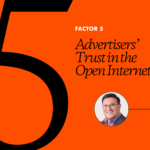In a world where even great content disappears in a scroll, how do publishers give their stories the longevity they deserve?
A well-respected publishing leader recently proudly announced the launch of a provocative weekly series that brings together some of the most powerful voices in politics, but I find myself wondering: Is new and exciting content alone enough to keep people returning week after week?
Faced with a content-flooded landscape, “Zero Click” search behavior, and volatile discovery channels, isn’t it now a strategic necessity for publishers to invest in fostering a lasting, direct audience connection?
Coming up with a great content hook is only half the battle. But a more complete strategy – and one that impacts the entire publishing ecosystem – would be to integrate seamless pathways for user interaction around that content, turning a one-sided conversation into a continuous dialogue.
Community is not a feature, it’s a philosophy.
Publishers are beginning to embrace this strategy. At a recent Digiday conference where AI was the central theme, I picked up on a powerful sub-theme: the industry’s shift from a focus on traffic to one of direct audience engagement and community-building. Digital publishers need to ask themselves if their audiences are merely spectators to a monologue or are they giving users the tools to connect and become a vital part of their brand? This applies to articles, podcasts, newsletters or any way they are connecting with readers.
It’s a shift in the publishing mindset toward understanding the profound impact community dynamics have on the relationship publishers have with their audiences, and ultimately the value of the brand.
Do you view your Audience as Content Consumers? Or Community Members?
Viewing the audience as content consumers might indicate a passive relationship. Passive relationships translate to retention challenges, high bounce rates, reduced session time, and weakened loyalty. Ultimately, passive consumption not only limits valuable first-party data but also translates directly into significant missed revenue opportunities, underscoring how this short-sighted view undervalues the audience’s true potential.
But adopting a community mindset establishes the long-term strategy, pivoting their model to ensure sites successfully operate as owned, intentional destinations. By actively integrating strategies that transform traffic into active participants and advocates, publishers are not only more resilient against all the external shifts (AI, SEO), but they build a self-sustaining ecosystem. A win-win-win for commercial, audience marketing, and editorial teams.
The Internal and External Realities
What needs to change inside the building? First of all, priorities and a rethinking of what success looks like. Community requires active planning and strategic consideration. Content, audience, product, data and commercial teams each have a stake, and need to be aligned. What are the goals? How can you measure success? Scale is no longer the objective. But retention, loyalty metrics, higher CPMs, editorial insights, data … these are tangible benefits that directly contribute to the overall health of the business.
The way publishers think about and understand their audience must change. Your audiences are not just readers. Their expectations have evolved, and users want to participate, not just consume. They want to be part of a dialogue that is transparent and authentic. They want to relate. Or influence. Or maybe debate. As Nina Gould, newly appointed Chief Innovation Officer at Forbes referenced in The Community Exchange Podcast: Editorial owns the storytelling, but it should reflect the voice of the audience to stay relevant. She recognizes the importance of giving people more to do directly on the site, of creating ways to extend the conversation, and of bringing that sense of satisfaction they get elsewhere into a choose-your-own-adventure experience.
A trusted space is absolutely critical for maintaining a respectful environment which is why deep engagement experiences go hand-in-hand with effective moderation.
Success Factors
Community is not just an add-on feature. When it becomes an integral part of a publisher’s ongoing strategy, there is a ripple effect that generates organic growth across every area of the business. Users feel part of something. They spend more time on site. You have more touch points to attract users to return. You maximize the value of every visit and drive more value from your traffic. Higher CPMs/RPMs. More registrations. More downloads. More data. Better insights. Deeper engagement means higher likelihood to convert on subscriptions, affiliate revenue, events. Nina Gould thinks in terms of the amount of interactions Forbes users are having on the site. Are they getting them to stay? Are they able to surface more things that they’re interested in, either content or experiences? Are they extending users’ relationship with their brand, such as signing up for a newsletter?
We see this every day across our network of 5000+ publishers: Commenters spend 3.6x more time on site, read 4.5x more pages and generate 4x revenue compared to passive readers. Today’s metrics are less about getting clicks and more about building a loyal fan base and driving emotional connections.
Sustaining Community Over Time
Building community is the start. Once you start nurturing this strategy, the opportunity gains momentum. I see this every day working with publishers to uncover the unlimited possibility that community offers: When tailored to the publisher’s site, conversation and connection can take many shapes. They can build community around content, around high-profile contributors, around shopping, movie reviews, events, podcasts, webinars, guides, games, etc. They can spotlight some of their best community engagement to keep a vibrant conversation going. They can create forums, hubs, or “town halls” to give the conversation its own space to grow. They can mold the buzz into its own section, newsletter, podcast or event. Not everyone will actively contribute directly to the conversation, but even indirect engagement (a thumbs up/down, answering a poll, reading the commentary) turns a reader into an active participant, so we offer a package of all-encompassing solutions into our platform. As publishers, you have the unique opportunity to do something better than Facebook and Redditt directly on your sites.
Publishers’ content is powerful, and when you build community around it, the real magic happens. You create a vibrant and dynamic space where influential voices are not just heard, but engaged with, transforming that weekly feature from a one-time read into a living, self-fueling dialogue.


